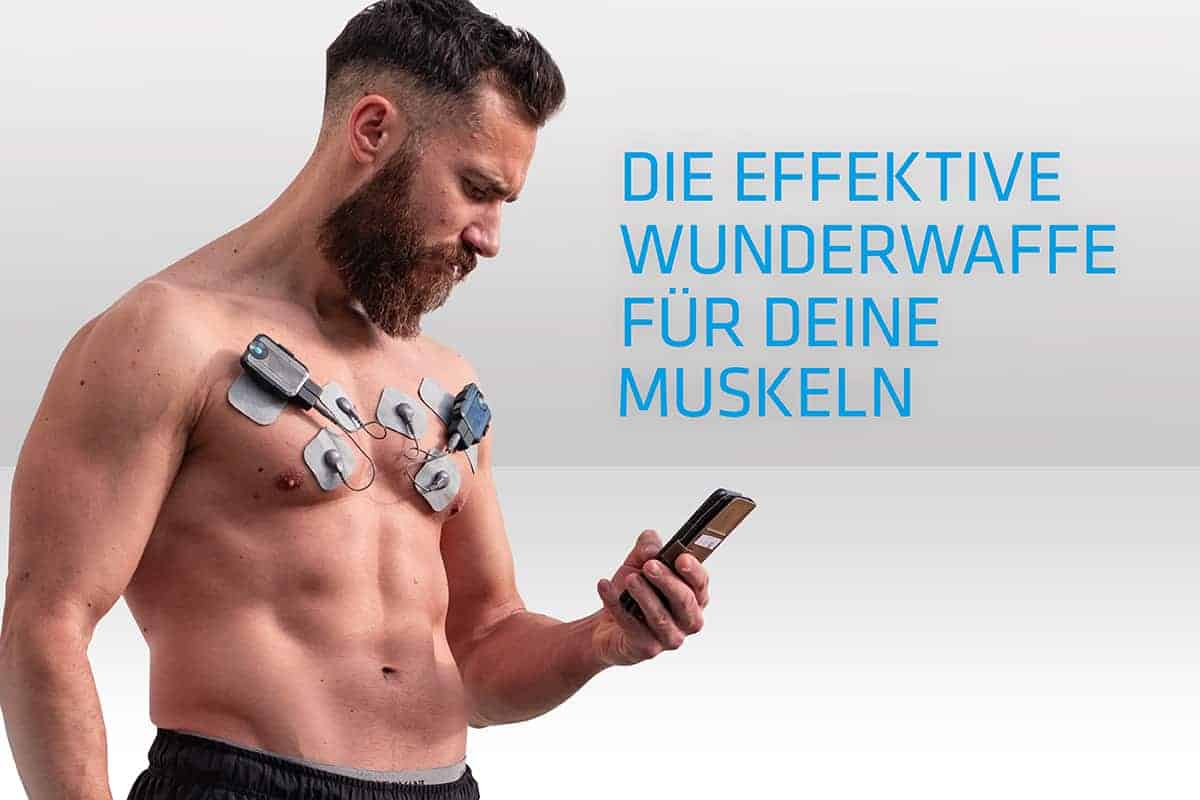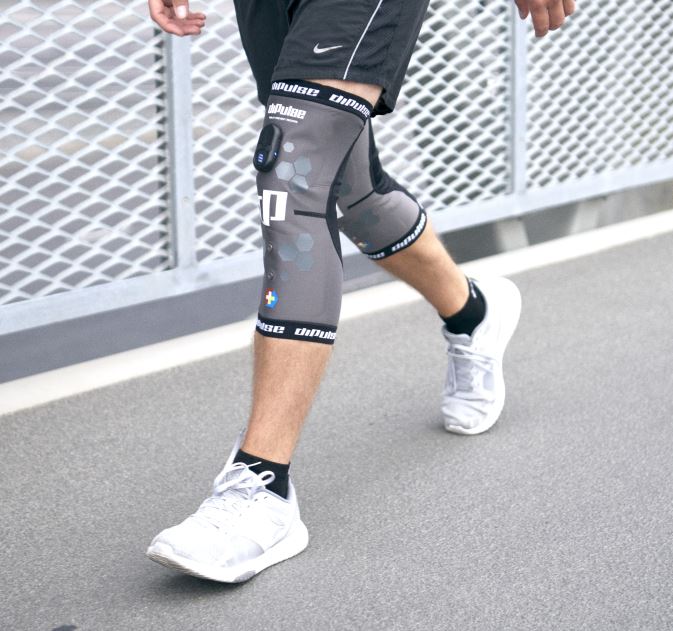ELECTRICAL MUSCLE STIMULATION – THE EFFECTIVE MIRACLE WEAPON FOR YOUR MUSCLES
Electrical muscle stimulation, or “EMS” for short, is a mega hit. EMS studios and EMS offers are popping up like mushrooms, promising to get the body and muscles into top shape with just a few short applications. But what is actually behind the training method and what are its advantages and disadvantages?
Basically, a muscle contraction occurs when the motor area of our brain generates an impulse that travels to the muscle fibril via a nerve and the motor end plate. This electrical impulse activates the actin and myosin filaments that carry out the contraction of the muscle.
This activity of motor switching points is usually closely related to our sensory system. In physiotherapy, one often says “no motor skills without sensors”. For example, if a joint is overloaded or injured, the brain receives information about the condition and evaluates and processes this information accordingly. In such a situation, a further maximum load on the joint through maximum muscle activity makes no sense. This inhibits the motor units and limits the activation of the muscles.
WHAT DOES THE ABBREVIATION “EMS” STAND FOR?
EMS stands for electrical muscle stimulation. The aim is to control and stimulate the muscles or individual muscle fibers in a targeted manner from the outside using electrical impulses. Using EMS, the entire body is trained during training and the deep-lying muscle groups are also addressed. The muscle stimuli with EMS application are many times higher than with intensive strength training. The EMS principle has been used in rehabilitation since the 1970s. In this way, electrical impulses can be set very early after injuries and operations in order to train muscles again and to bring them back to normal stress. Different forms of current are used in connection with special frequencies to enable muscle contractions without impulses from the brain.
In addition to these possibilities, electrostimulation was used in Russia in the early years to improve the performance of athletes. Certain muscles or entire muscle groups are stimulated in addition to the already intensive training, so that they are built up even more and the performance possibilities increase further. However, EMS is not only used in competitive sports. Recreational athletes can also use EMS to supplement their training, make exercise more enjoyable or add more variety to their workouts.
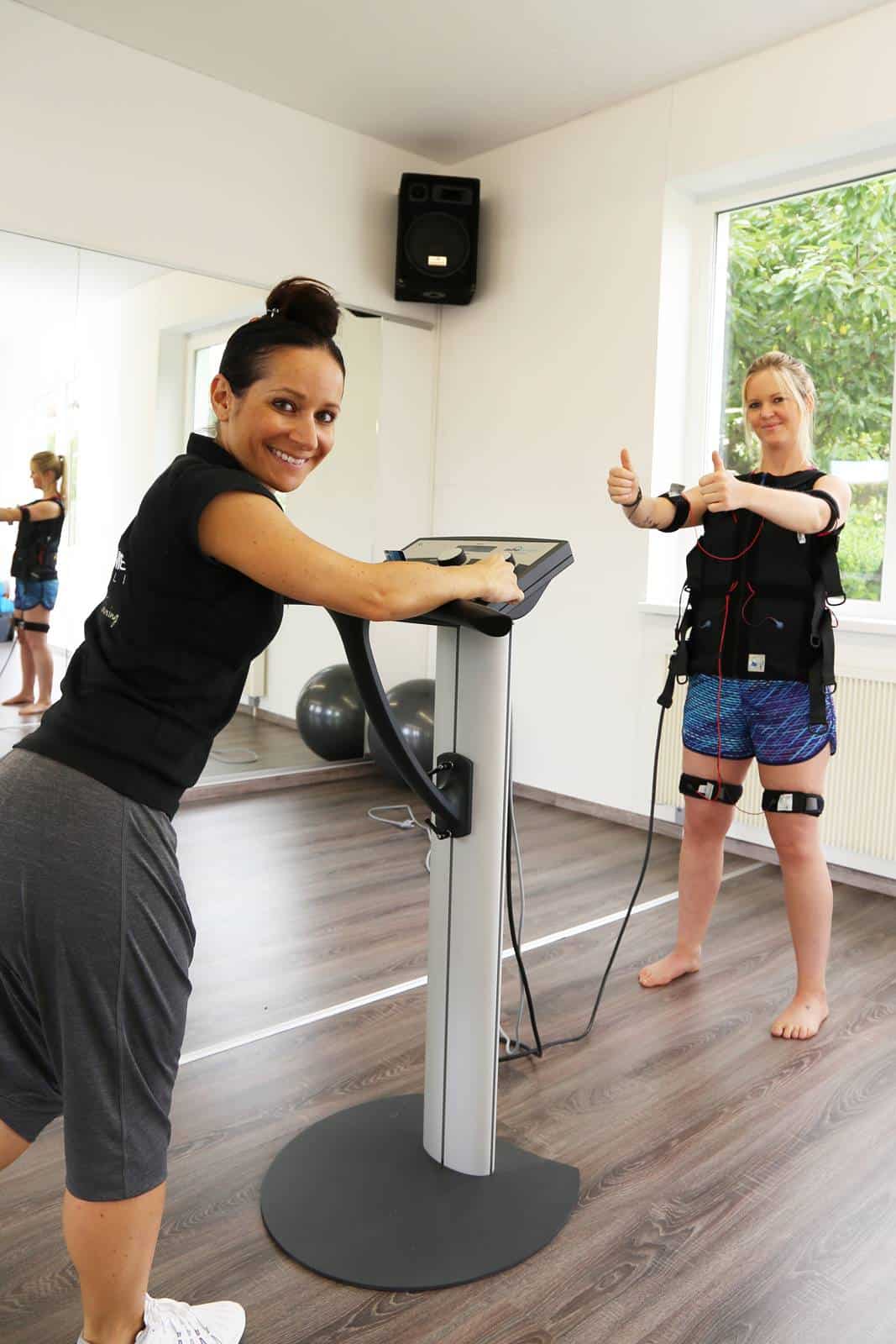
Original EMS training with cabling: The patient is always limited to a certain extent because he is connected to the EMS device via cables. (© Premium personal trainer Stephanie Lutrelli)
HOW DOES EMS TRAINING WORK?
The high-intensity EMS training aims to stimulate the muscles through electrical stimuli. Low or medium frequencies are used, which are harmless to humans when used correctly. The electrical impulses trigger a brief muscle twitch. Several of these impulses in a row cause a complete muscle contraction, as it also occurs during normal training. In this way, all large muscle groups are trained at the same time and deeper muscles are also optimally reached. Regardless of whether your goal is to lose weight, build muscle or train your endurance – with EMS you can achieve maximum training success in a short time.
NMES or EMS APPLICATIONS
In the past, electrical currents were mostly generated by devices and transmitted to the skin via cables and electrodes. Nowadays, for example, electrodes are integrated into skin-tight shirts and pants, which thanks to wireless technology can often be used without cables and controlled via an app. This form of application makes it possible to train individual movements or sequences of movements in a very flexible manner parallel to electrical stimulation.
NMES WITH DIPULSE – THE WIRELESS TRAINING METHOD
In particular, the company diPulse has further developed the simple idea of EMS and now enables this training method completely without restrictive cabling. Based on physiological specifications, diPulse calls the application “NMES”: Neuromuscular Electrical Stimulation.
In cooperation with the partner company FENC, a specialist for high-tech functional clothing, highly complex textiles with fully integrated and very large contact areas made of carbon nanotubes were developed. At specific, easily accessible muscle points, the conductive tracks are connected via two magnetic contacts to so-called »Stims« that can receive impulses from outside via Bluetooth Smart and then transmit electrical signals to the conductive tracks in the textile fabric. This process is controlled via an app and Bluetooth Smart on the smartphone or tablet.
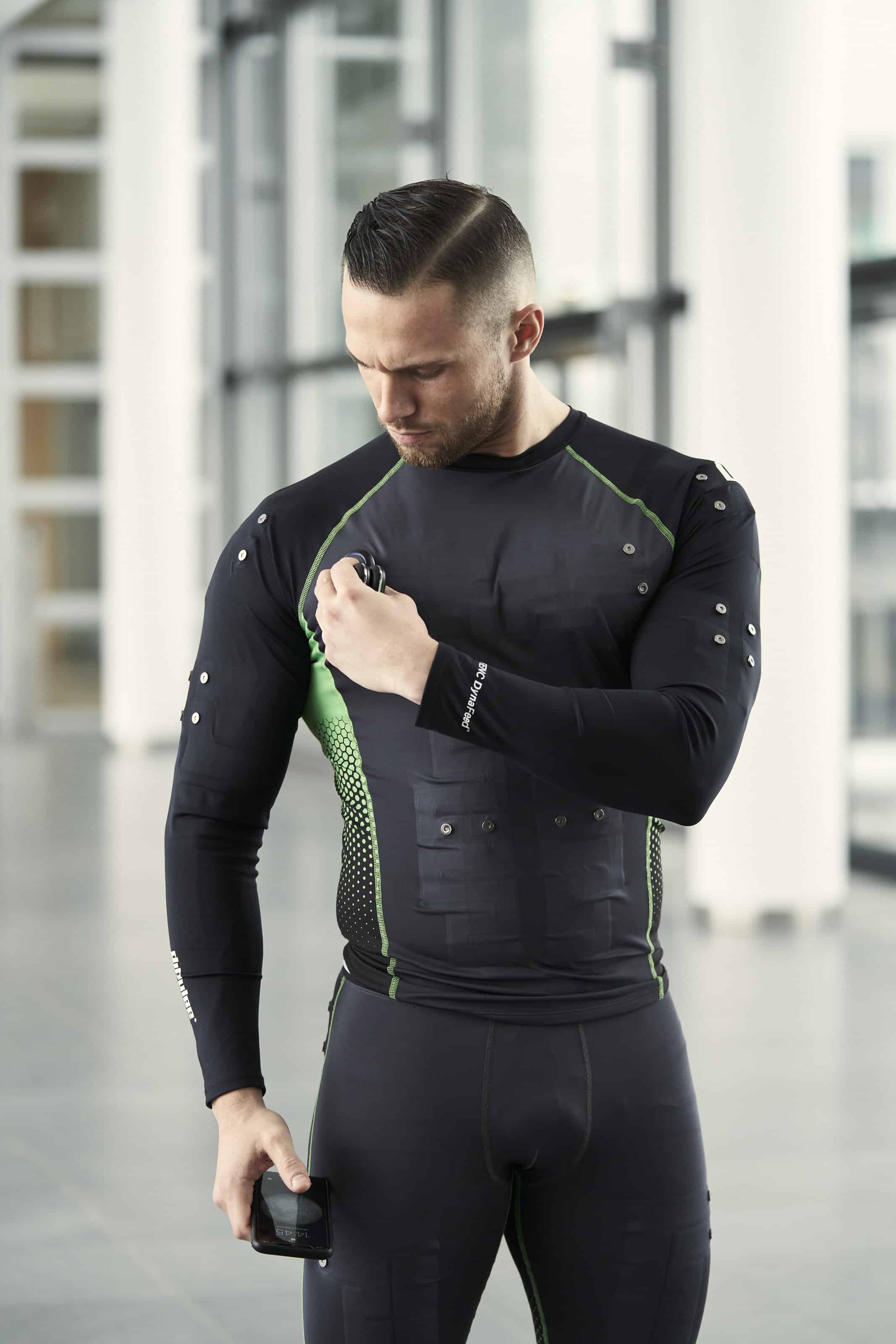
The so-called “stims” are simply magnetically attached to the designated ports.
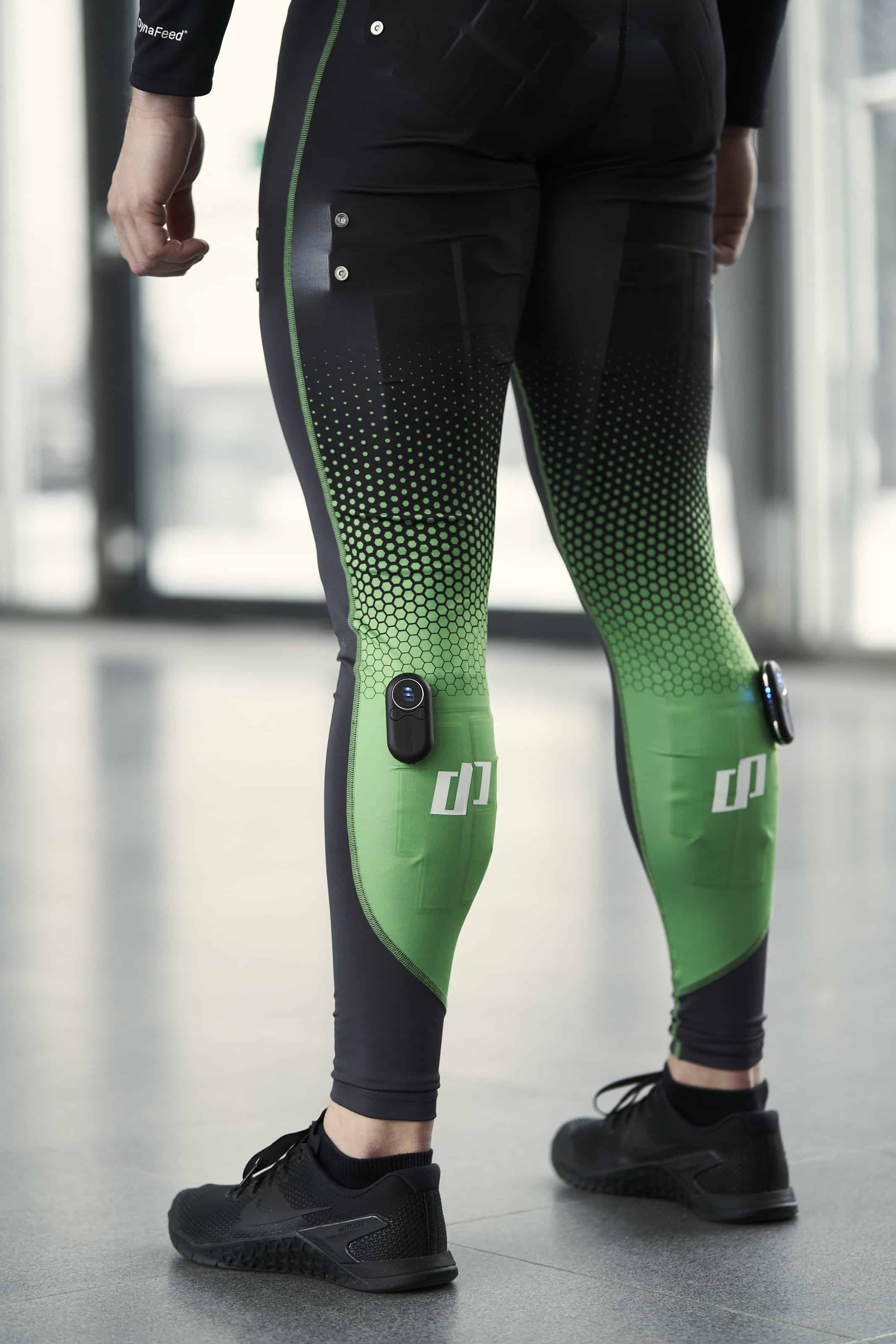
Various attachment points for stims are firmly integrated on each diPulse Sportswear garment.
In addition to shirt and pants, there is also a knee bandage. . In the case of knee joint problems, the quadriceps muscle and especially the vastus medialis muscle are only activated to a reduced extent and recede. The resulting lack of co-contraction promotes the problem in the joint! The knee bandage enables the targeted (re)building of this muscle group in order to ensure the stability of the knee. There is also a belt that was specially developed to stimulate the abdominal and back muscles. With back problems you can strengthen important muscles and perform movements in the right co-contractions.
The app for smartphones and tablets opens a wide range of applications, for example with TENS, massage or even rehabilitation applications. DiPulse products and programs allow you to build muscle without additional equipment, anywhere and anytime.
BLUETENS® – ELECTROSTIMULATION FOR ON THE GO
In addition to diPulse, the electrical muscle stimulation devices from Bluetens® are perfect for use at home or for training on the go. Thanks to the exchangeable adhesive electrodes, a smart control unit and the convenient control via smartphone app, it has never been easier to benefit from the advantages of electrical stimulation. Bluetens® can not only help you to relieve pain, but it also helps relax tense muscles. The handy size, wireless use and the travel bag that can be ordered as an accessory make using the Bluetens® devices child’s play.

Using Bluetens® Classic is child’s play. With the Wireless Pack, the session even works completely without cables.
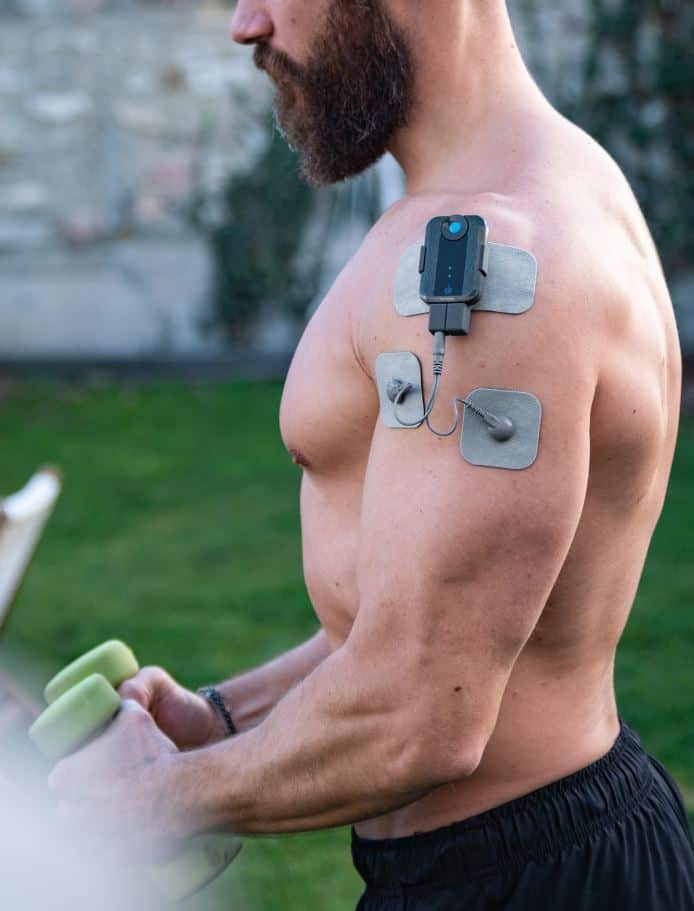
The Bluetens® Duo Sport has two Bluetens® devices in black as standard. The pulse generators are attached directly to the adhesive electrodes.
With NMES, movements are not restricted by restrictive clothing or wiring. This allows you a variety of training options, for example in the areas of endurance, strength, hypertrophy training and many more. In contrast to other EMS applications, only two muscles are activated at the same time for health reasons, otherwise the different body systems could be overloaded. This protective function is an essential difference to the otherwise known functional fitness training in studios accompanied by a trainer.
SUMMARY
»Life is movement« – for this we need the many functions of our body. The muscles play a crucial role in this. Therefore, they should also be trained in a variety of ways. Especially when the optimal activation of the muscles is not possible due to injuries, operations or degenerative problems. With EMS, muscle contractions are triggered by current impulses, in particular to reach deeper muscle layers. This training method is ideal for people who are short on time. NMES is a great way to stimulate the muscles in a targeted manner. However, the method should be supplemented with a variety of movement patterns in order to integrate the newly acquired strength into the “human system” in a neuromuscular way as well.
EMS and NMES training can support muscle building or fat loss but are not a substitute for conventional strength training or endurance training. You will achieve the best results when you combine classic strength training and EMS / NMES.

